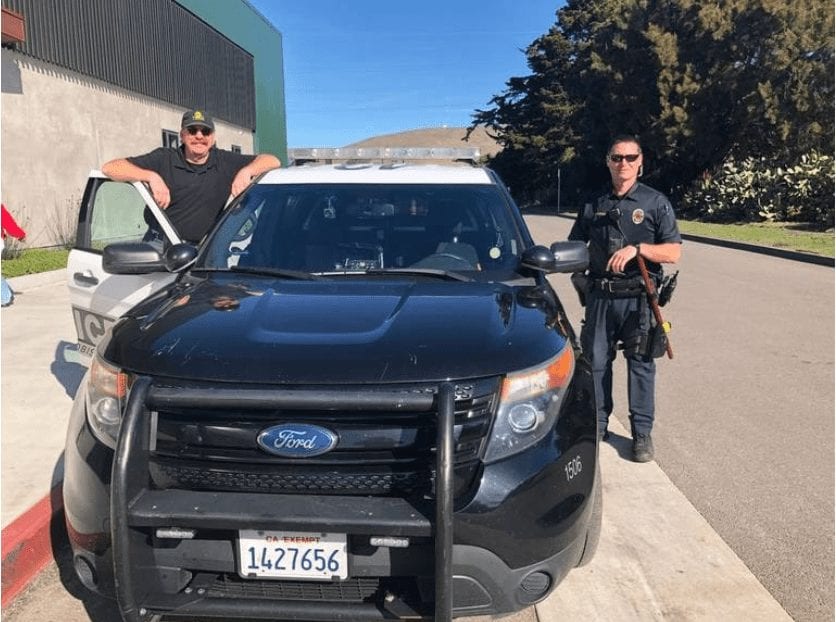Our Team
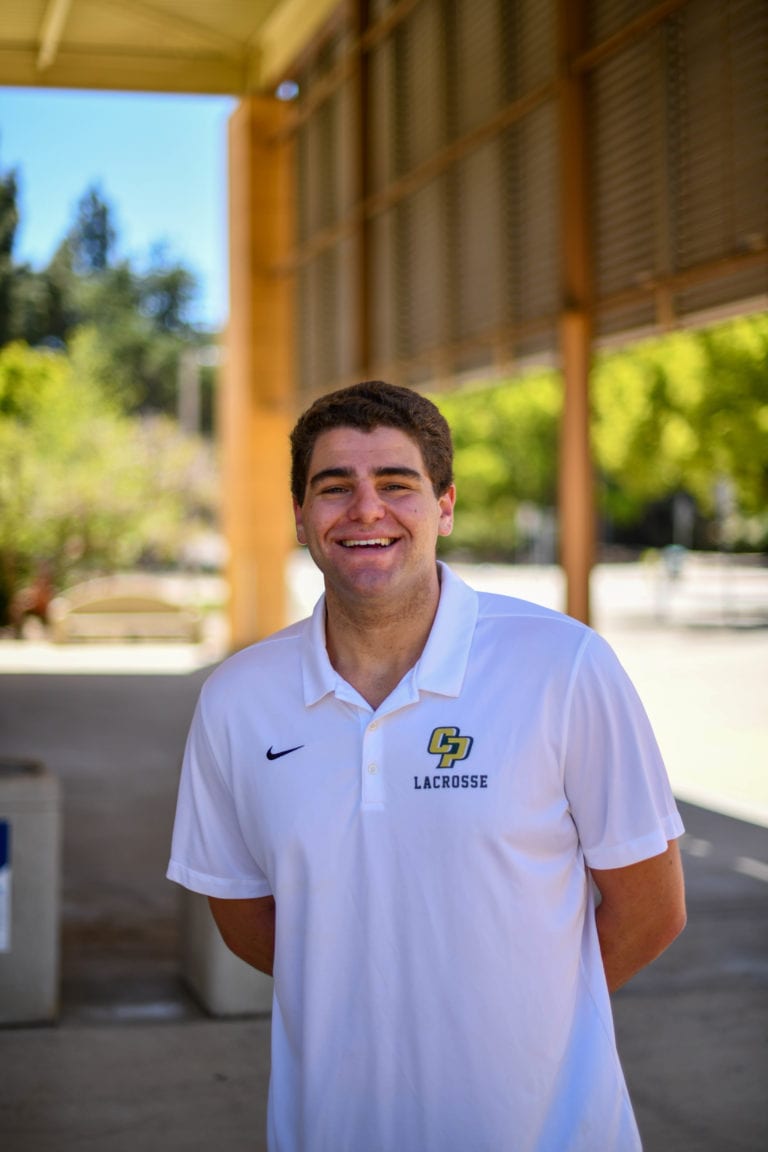
Ethan Norman
Industrial Engineer
Ethan Norman is a fourth-year Industrial Engineering student at Cal Poly, San Luis Obispo, who has developed a passion for project management and sales during his undergraduate schooling. Since coming to Cal Poly from Baltimore, MD, Ethan has been developing a strong engineering background through his coursework while simultaneously gaining project engineering experience with The Whiting Turner Contracting Company each Summer. Upon graduating in June 2021, Ethan will be joining Whiting Turner as a full-time Project Engineer in San Diego, California.

Brandon Drury
Industrial Engineer
Brandon Drury is a fourth-year Industrial Engineering student at Cal Poly, San Luis Obispo. Brandon is from the East Bay of California and has developed a passion for technical sales during his undergraduate schooling. Upon graduating Cal Poly in 2021, he will be joining Trane Technologies as a full-time New Systems Sales Engineer in the Pacific Coast Trane office located in the East Bay.
Acknowledgements
The project team would like to acknowledge Professor Jill Speece, SLOPD Officer Tim Koznek, and Social Worker John Klevins. Thank you all for the constant support throughout this project.
Our Project's Videos
Our Project's Digital Poster
The Problem
SLOPD has issued a Community Action Team (CAT) that consists of Tim Koznek (SLOPD) and John Klevins (social worker – TMHA) to deal with the multifaceted issue of homelessness in SLO.
Socially, the homeless often generate complaints from the citizens of SLO as well as within the homeless community itself. This leads to fights, assaults, and other altercations between the homeless. This is a deterrent to the public’s utilization of open spaces such as parks, hiking/biking trails and the downtown commercial area. Environmentally, the homeless resort to leaving trash throughout these public spaces which, along with them bathing and defecating in creeks, leads to contaminated waterways. The trash and excrement not only negatively impacts the environment in the city, but as it moves down the watershed, can affect the county, state and ocean. Financially, pedestrians are often harassed by the homeless in the downtown commercial areas, which deters consumers from visiting businesses located in the area. The closure of homeless encampments also increases the cost to the city as public employees are then required to clean up after the homeless to mitigate these consequences. The CAT’s goal is to provide help to these homeless individuals and provide them with adequate services to ultimately assist these individuals in finding permanent housing solutions.
3 Solutions
Google Form – With proper data tracking and collection, the CAT would be able to more effectively assist the homeless population, develop long term relationships, and ultimately help them increase their service usage. We included every field which Klevins was already collecting and provided selection options to prevent the data cleaning we had to do when analyzing his past records. Google Forms also automatically creates a live data analytics dashboard and can view results in Google Sheets or a downloadable CSV file.
Pamphlet – When designing their first pamphlet, they first wanted to reduce the chance of cognitive overload and remove the clutter from the pamphlet then add colors, pictures, and organization. Besides reducing the amount of raw information being presented, the project team wanted to make a data driven decision ordering the service categories. Klevins was able to inform them that 80% of the services utilized fall under the Mental Health, Drug & Alcohol Services, Food, or Clothing categories. After learning this statistic, the SLOPD team decided to utilize the Pareto Principle. Therefore, these three services which serve as the 20% were placed first on the brochure.
The project team then created an Informational Brochure which is much more like the unused pamphlet from 2018 but has some key changes. First, all information was updated and verified, color was added, then categories were ordered using the Pareto Principle.
Website – Fully incorporated website can be found at https://www.slocity.org/living/neighborhood/homelessness-solutions. Upon redesigning the current state of the website, the main goal was to update the hyperlinks with valid services and to delete unnecessary resources. Each service presented in the current state of the website was replaced with the correlating services logo. Upon clicking on the image, the user is taken to the website shown. The links were reordered in alphabetical order and URLs updated. A section for helpful programs and links was also incorporated as well as two ways to donate directly to the homeless population.
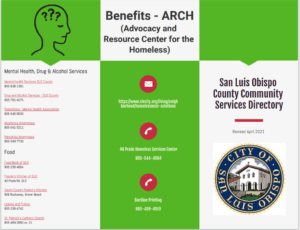
Above is the visual pleasing brochure aimed, to reduce cognitive overload.
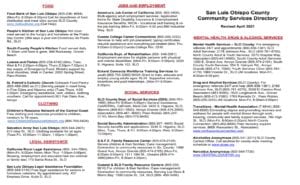
Above is the informational brochure, aimed to provide detail information about services in SLO.
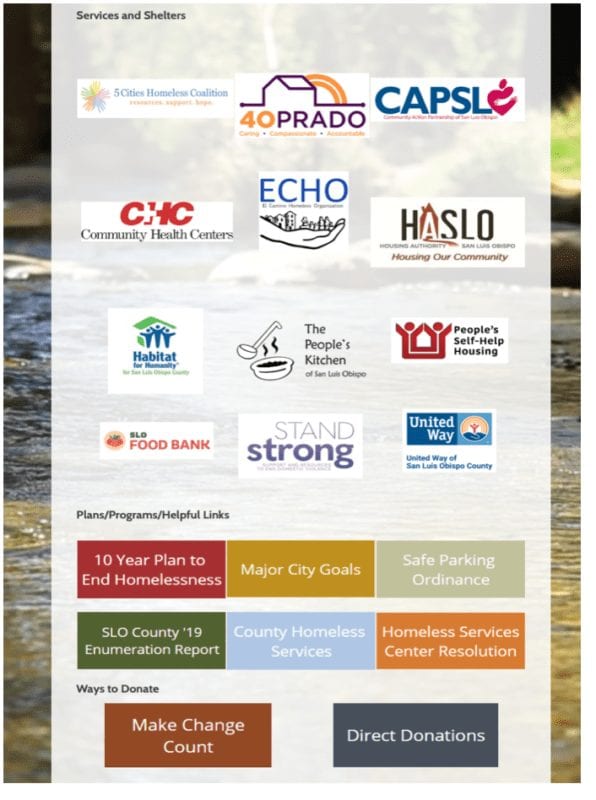
Above is the updated and fully incorporated new website.
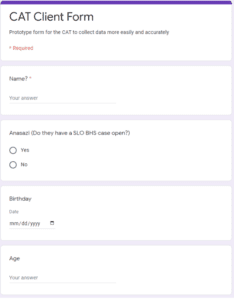
Above is the Google Form used to improve data collection on homeless individuals.

SLPOPD
This project is sponsored by SLOPD
The Current State
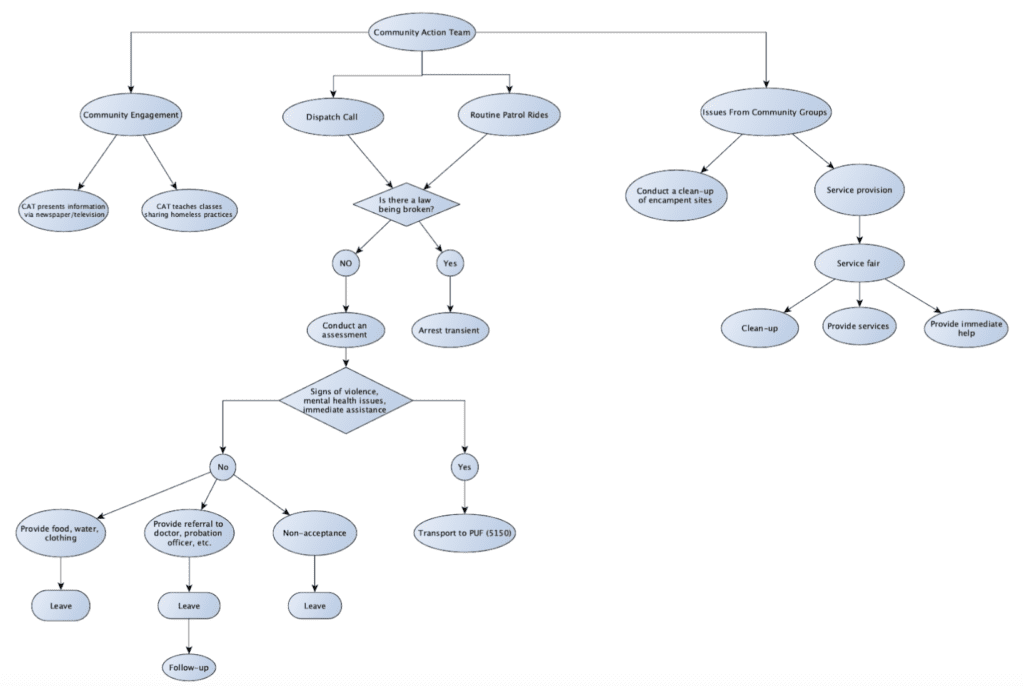
Data Collection – Klevins takes handwritten notes to record data in the field when interacting with his clients. Once he is back in the office, he then transcribes the notes into an Excel spreadsheet. This method of data transfer led to many data inconsistencies and significant data cleaning before analysis.
Service Presentation – As different services are needed the CAT will pass out an informational pamphlet the size of a pocket-square with different services. The pamphlet is in small print, black and white and each category has a simple bolded title. Each category seems to list the services in no order but the categories themselves are organized alphabetically. The information being used is from April 2016 and many of the services have inaccurate information or simply don’t exist anymore.
Website – The site (https://www.slocity.org/living/neighborhood/homelessness-solutions) was meant to have a list of resources to connect the homeless and public with services but many of the links didn’t work or simply do not exist anymore. The project team met with Ms. Victoria Tonikian, the manager of the SLO City webpage, and received approval to redesign the website with an easy-to-use interface.
Current State Photos
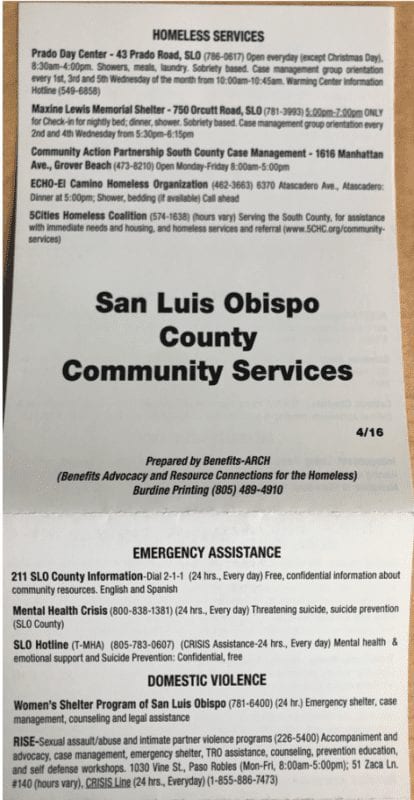
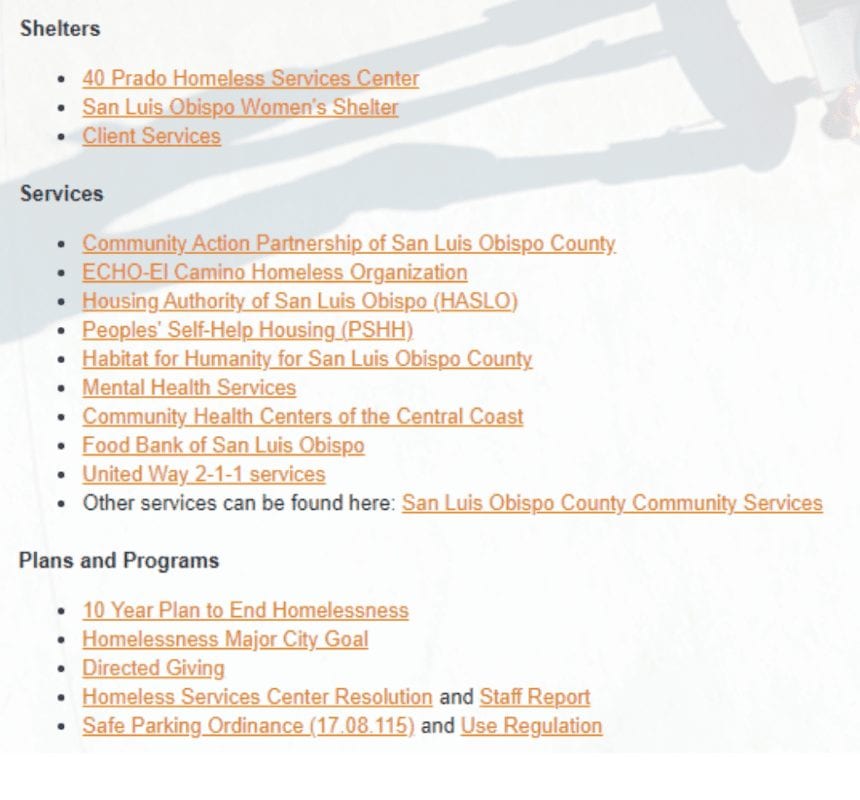
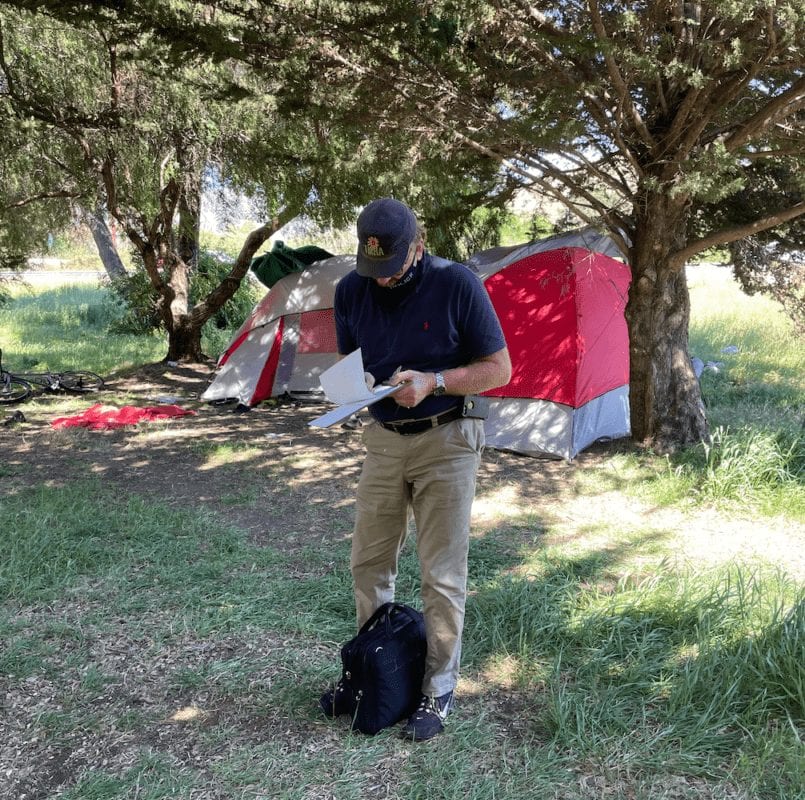
Testing

Above is a site traffic analysis of the current state of the website. The objective is to generate 100 site visits by May 2022.
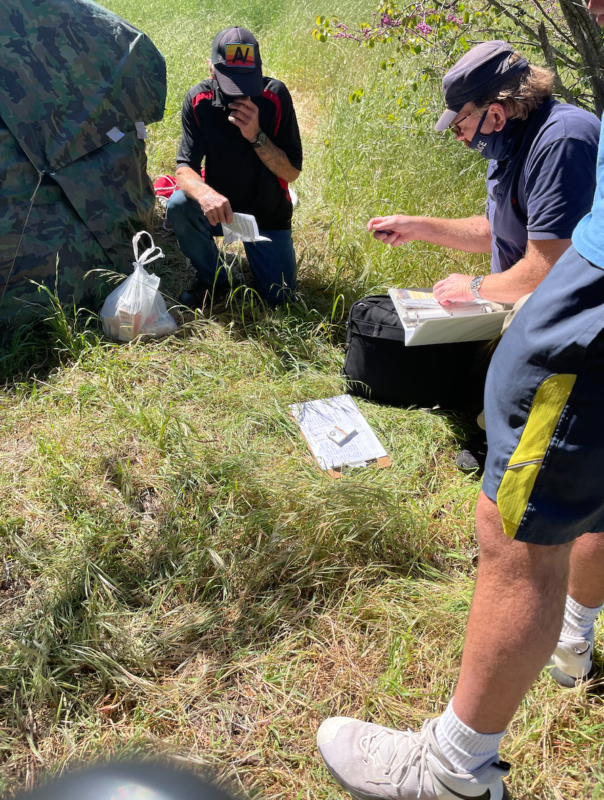
Above is a photo of the project team and the CAT testing the effectiveness of the new brochures.
Testing conclusions
Google Form – Verified but not validated. Klevins was able to relay that the Google Form will save him an immense amount of time by not having to transcribe his notes. It is much cleaner and more efficient by being able to view responses on an analytics dashboard or by being able to view specific records in a Google Sheet. The ability to download data to a CSV file which can then be uploaded to Apricot, SLOPD’s current data management system, is also extremely useful. Lastly, the data being collected in real time not only allows the data analytics dashboard to be updated automatically but removes any need for Klevins to update spreadsheets manually which is where most errors would occur.
Pamphlet – On April 29, the team completed their only site visit. Klevins would make his normal introduction to the client as Brandon and Ethan would randomly decide which pamphlet to hand that client. Ethan then said: “We’re Cal Poly students trying to improve the presentation of services to the community. Could you please rank on a scale from 1-10 how likely you would be to accept a service based on the way they are presented to you in this brochure.”
The team spoke with 16 people total. The average answer for the Informational Brochure was 4.71 and the average for the visual brochure was 3.75. Both very low scores but key insight was gained during this site visit. All the details in the informational brochure are essential for connecting the client to the service. Especially as many clients don’t have cell phones, Klevins had to turn back to the team several times and ask for the Informational Brochure when we were showing the Visually Appealing one because the client needed an address, or hours of operation, or other minute details which had been omitted for display purposes.
After that initial site visit, the team pivoted from the original Design of Experiments and planned to only hand out the Informational Brochure on following site visits.
Website – As of May 4, the new website has been published. There had only been 6 visits in the previous 8 months. Our goal is to hit 100 views by May 2022.
The Objective
The CAT’s goal is to provide help to these homeless individuals and provide them with adequate services to ultimately assist these individuals in finding permanent housing solutions.
Per the 2019 SLO County census and point-in-time count, the homeless population is estimated to be between 1200-1600 persons. According to the CAT, most of the homeless population in SLO are content with their lifestyle and do not seek permanent housing solutions. However, most of the homeless population accept services of some degree (food, clothing, referrals). Shown below is the project teams’ key performance indicator. 53% of the current homeless population accept services of some kind. Thus, the senior project’s objective is to improve the rate of services accepted / services offered.
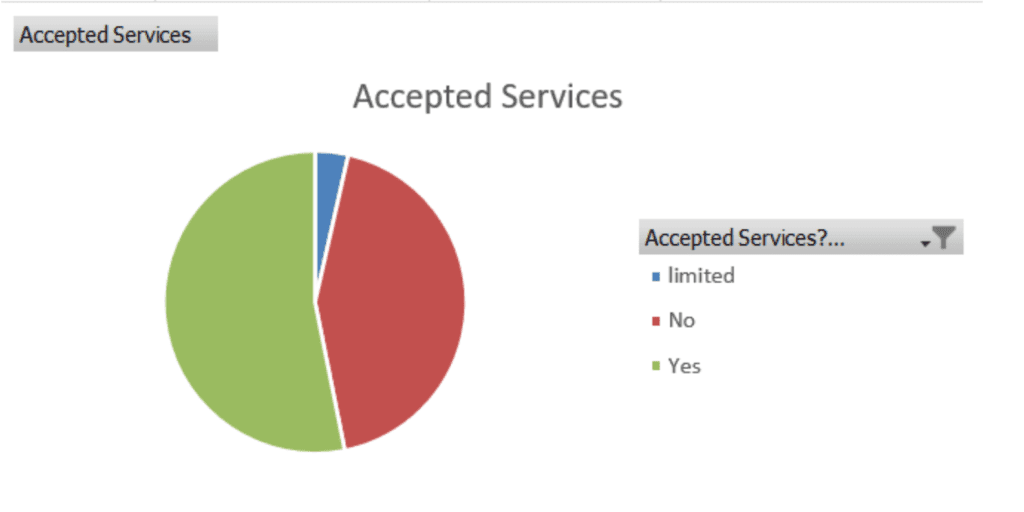
Impact Analysis
SLOPD Man Hours: 33,341 hours x $41.75/hour = $1.4 Million
Wanted Pamphlet: 11/16 = .6875 = 68.75% → KPI up from 53% → 68.75 – 53 = 16%
Through the Team’s site visit, they interacted with 16 people total, 11 of whom voluntarily kept the pamphlets given to them. That comes to a rate of 68.75% which can be seen as a 15.75% increase from the original KPI of 53%. The project team undoubtedly improved efficiency for SLOPD, but the effect is hard to quantify. If the form, pamphlet, and website combine to even make a 1% dent in the number of homeless calls SLOPD receives in a year, that would amount to $13,919 in savings.
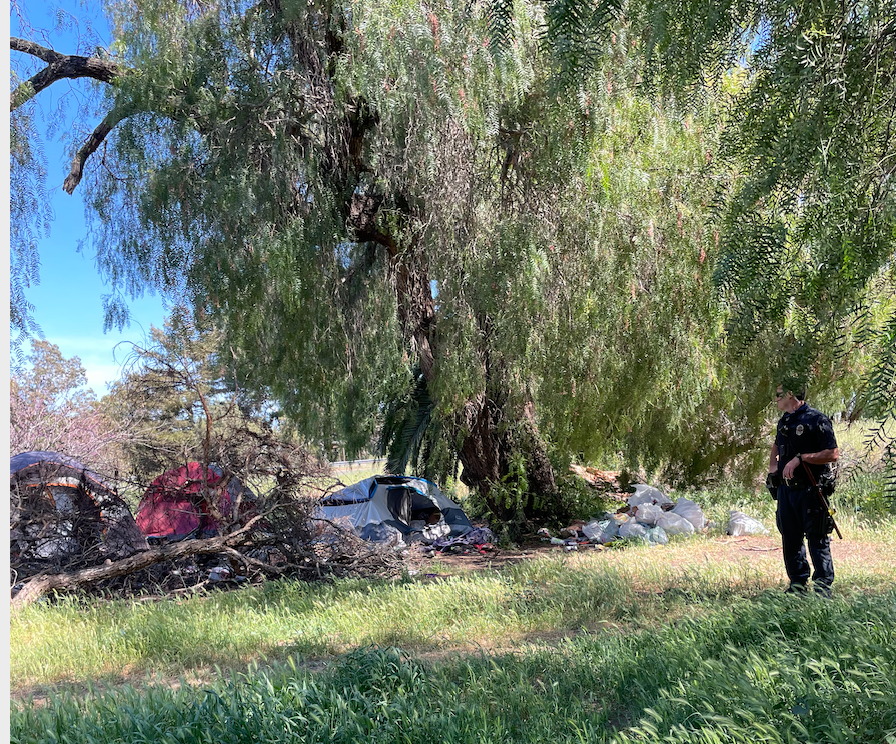
Officer Tim Koznek near a homeless encampment in SLO.
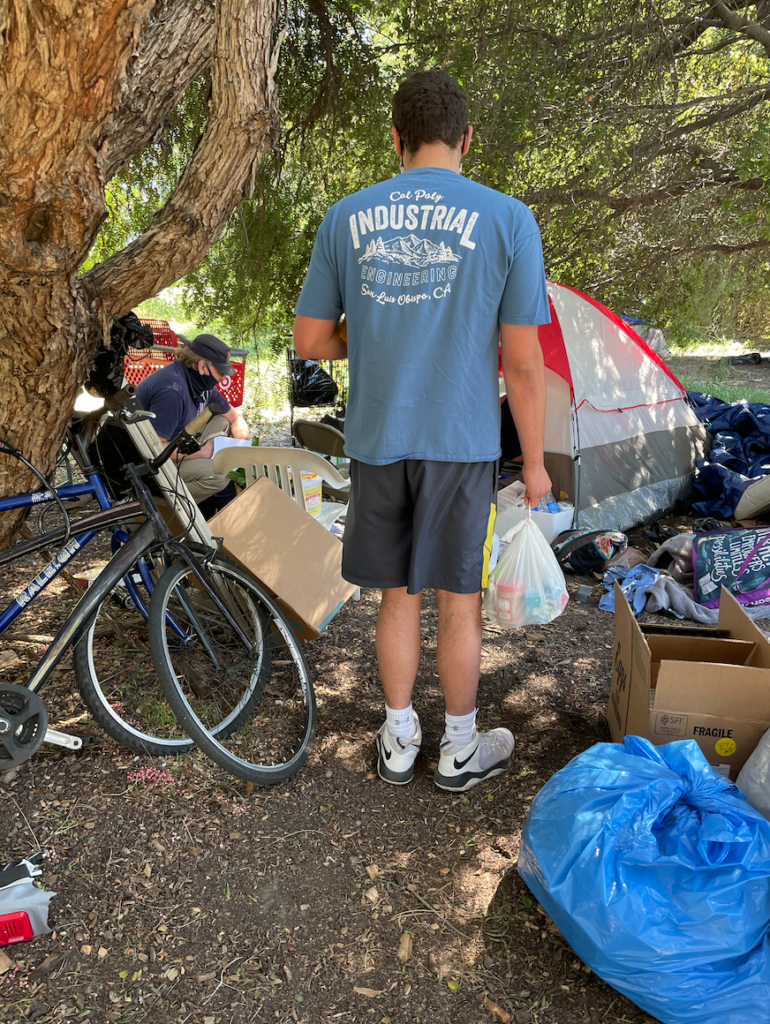
Project team member Ethan Norman engaging with a homeless individual.
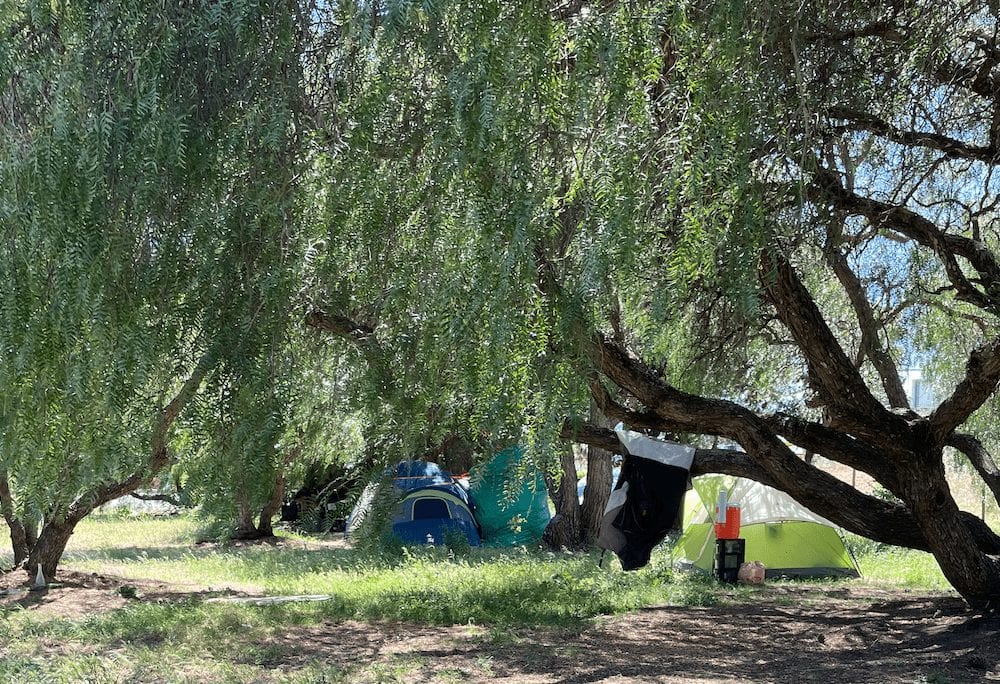
A homeless encampment of the side of a highway located in SLO
Conclusions
In conclusion, the project team was able to update and improve critical communication information to not only the homeless themselves but to the SLO community as a whole. They also helped to organize the CAT’s data collection and management methods. Lastly, the team provided a detailed analysis of the CAT’s procedural inefficiencies.
If this Senior Project were to be handed down to a future group, we have a few recommendations. First, that the project team do patrol rides early and often throughout the year to finish the pamphlet DOE and to address the other two processes of engagements. We also recommend evaluating the methods of community engagement. Due to Covid-19, most typical community engagement processes were cancelled or postponed. Community engagement can be explored to see potential solutions that incorporate third party organizations and SLO citizens. In addition, issues from community groups can be explored to test potential solutions that arise during annual service fairs and clean-ups. Again, these avenues were not possible due to Covid-19, however, if this project were to be passed down, these engagement processes should be continued by SLOPD and explored by the project team. Lastly, the project team recommends that any future group should advertise the newly incorporated website. From the site traffic analysis, it can be concluded that this resource is unknown to the general public as well as the homeless population. It is a great resource and offers the most sought-after long-term services.

